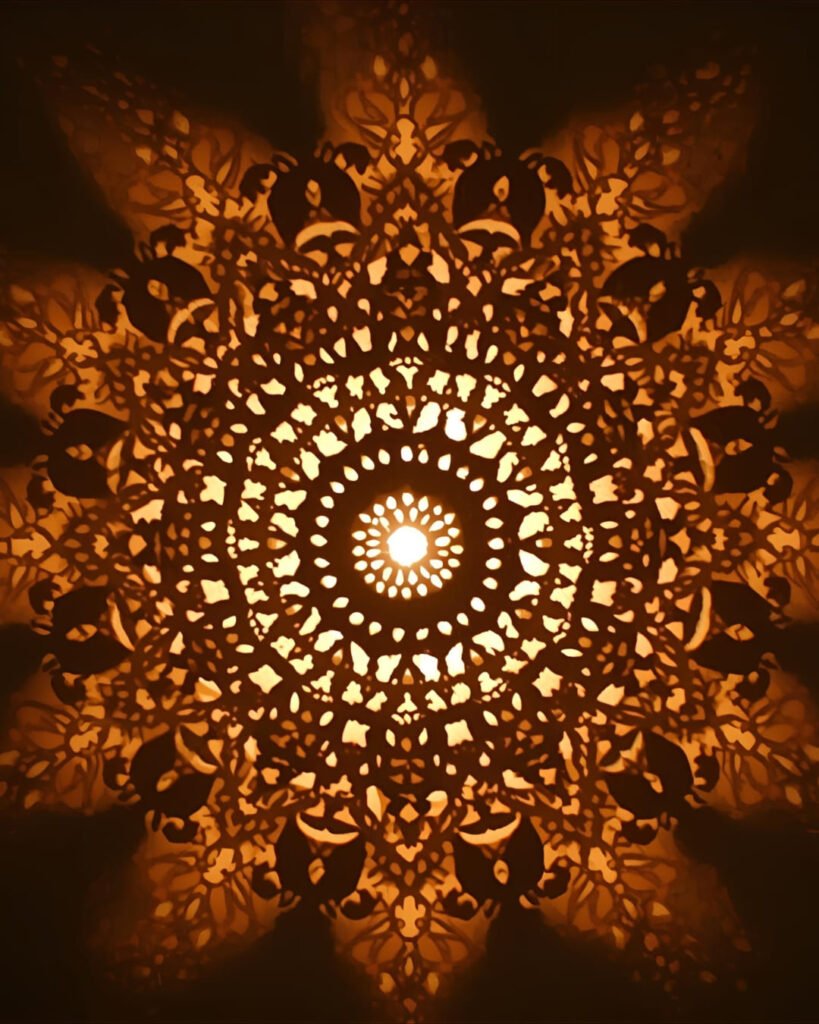
Rangoli is one of the most beautiful traditions in India. You might see it on the floor outside homes during festivals. Bright colors, flower petals, and rice flour come together to make patterns that bring joy and blessings. But did you know that every region in India has its own type of Rangoli? Some call it Kolam, others say Muggu, Alpana, or Mandana. Each regional rangoli has its own story, materials, and purpose. Let’s take a colorful tour around types of rangoli designs across India and discover how every state celebrates this ancient art in its own unique way!
Quick Navigation
The Soul of Rangoli
Before we explore regional rangolis, let’s understand why people make Rangoli in the first place.
In ancient times, people believed Rangoli brought luck, happiness, and harmony. It was also a way to welcome guests and gods. Women would wake up early, clean the front yard, and draw patterns with rice flour , a symbol of feeding small creatures and spreading kindness.
Today, Rangoli is not only a tradition but also an expression of creativity. Millions of people post Rangoli pictures online every festival season, keeping this art alive for future generations.
South India – Kolam and Muggu
In Tamil Nadu, Andhra Pradesh, and Karnataka, the first thing you might notice at dawn is women bending down, drawing Kolam or Muggu at their doorstep. They use rice flour or chalk powder, making symmetrical patterns filled with dots and lines.
Each design starts with small white dots (called pulli or chukka), then lines join them into flowers, birds, or spirals.
Symbolism:
Kolam is believed to bring prosperity and positive energy into the home. The rice flour also feeds ants and birds, a gentle way to share nature’s gifts.
Fun Fact:
In Tamil Nadu, Andhra Pradesh, Telangana, there’s even a Kolam competition or rangoli contests, during Sankranti in schools and workplaces. Some designs can stretch up to 10 feet wide and use over 1,000 dots.
Expert Tip:
Mix a pinch of fine sand or salt into rice flour for a smoother texture and better grip on the floor.

Western India Rangoli– Mandana and Saanjhi
In Rajasthan and Madhya Pradesh, the tradition is called Mandana, which means “to decorate.” People draw these designs on mud walls and floors using chalk paste and red clay.
Mandana motifs often show animals, temples, and geometric shapes. The designs are handed down from mothers to daughters , no stencils, just pure memory and imagination.
In Uttar Pradesh, another form of regional rangoli called Saanjhi is made with paper stencils. It’s especially popular in Mathura and Vrindavan, the land of Lord Krishna. The patterns often show Radha and Krishna’s stories.
Fun Fact:
Saanjhi, the regional rangoli of Uttar Pradesh, is considered one of India’s oldest stencil art forms , dating back over 500 years!
Expert Tip:
For a modern twist, try painting Mandana motifs on old clay pots or walls for rustic home décor.

Eastern India Rangoli– Alpana and Aripana
Moving east, in West Bengal, you’ll find Alpana, and in Bihar, Aripana. These regional rangolis are drawn using a paste of rice and water, not colored powder. Alpana designs are mostly circular, filled with fish, lotus, footprints, and conch shells , symbols of good fortune and Goddess Lakshmi.
In villages, women still make Alpana during Durga Puja and Lakshmi Puja, praying for wealth and protection.
Fun Fact:
The name “Alpana” comes from the Sanskrit word alimpana, meaning “to coat or plaster.” Ancient Indian queens used to make Alpana during royal ceremonies!
Expert Tip:
Add a little milk to your rice paste , it helps the design shine and stay longer.

Central & Western India – Rangoli of Maharashtra and Gujarat
If you’ve seen bright colored Rangolis during Diwali , that’s the style from Maharashtra and Gujarat. Here, people use colored powders, flowers, and even diyas to make lively patterns.
Rangolis often include peacocks, lamps, mango leaves, and geometric borders. Every Diwali, families come together to decorate doorsteps and courtyards. It’s said to welcome Goddess Lakshmi , the goddess of wealth.
Statistic:
According to a 2023 cultural survey, over 80% of Indian households make some form of Rangoli during Diwali!
Expert Tip:
Use a cotton ball dipped in oil to lightly dab your colors , it gives a soft glow under lamps.
Fun Fact:
In some Gujarati families, young girls make their first Rangoli after turning 13 , a sign of growing up and taking part in traditions.

Northern India Rangoli– Chowk Purana
In Punjab, Haryana, and Himachal Pradesh, you’ll find Chowk Purana, made during Karva Chauth and Diwali. These designs are simpler but filled with meaning , small squares or circles made using flour, turmeric, and vermilion. People believe these drawings invite Goddess Lakshmi and bless the family.
Fun Fact:
In some villages, kids have “Rangoli contests” where the winner gets homemade sweets!
Expert Tip:
Use a soft brush or stick instead of fingers for more control if you’re new to Chowk designs.

Rangoli’s Modern Journey
Today, Rangoli has entered modern spaces , schools, offices, malls, and even social media! Designs inspired by geometry, abstract art, and nature are trending. There are now Rangoli design apps and online contests with thousands of participants across the Incredible India. But the heart remains the same, to spread joy, beauty, and peace.
Every Rangoli Tells a Story
From the white dots of Kolam in Tamil Nadu to the bright petals of Gujarat’s Diwali Rangolis , every pattern is a story of love and devotion.
Rangoli connects generations. It’s not just art , it’s emotion and an intricate part of the Indian culture. So next time you pick up a bowl of color, remember , you’re keeping a 2,000-year-old tradition – regional rangoli, alive.
Swetha is a Content Specialist, LinkedIn Branding and B2B Marketing Consultant. When she is not in the world of B2B, she researches the roots and beauty of Indian Culture and Traditions. She is the author of the book: 365 Days 365 Posts – The Guide to LinkedIn Personal Branding, available exclusively on Amazon. Connect with her on LinkedIn.
